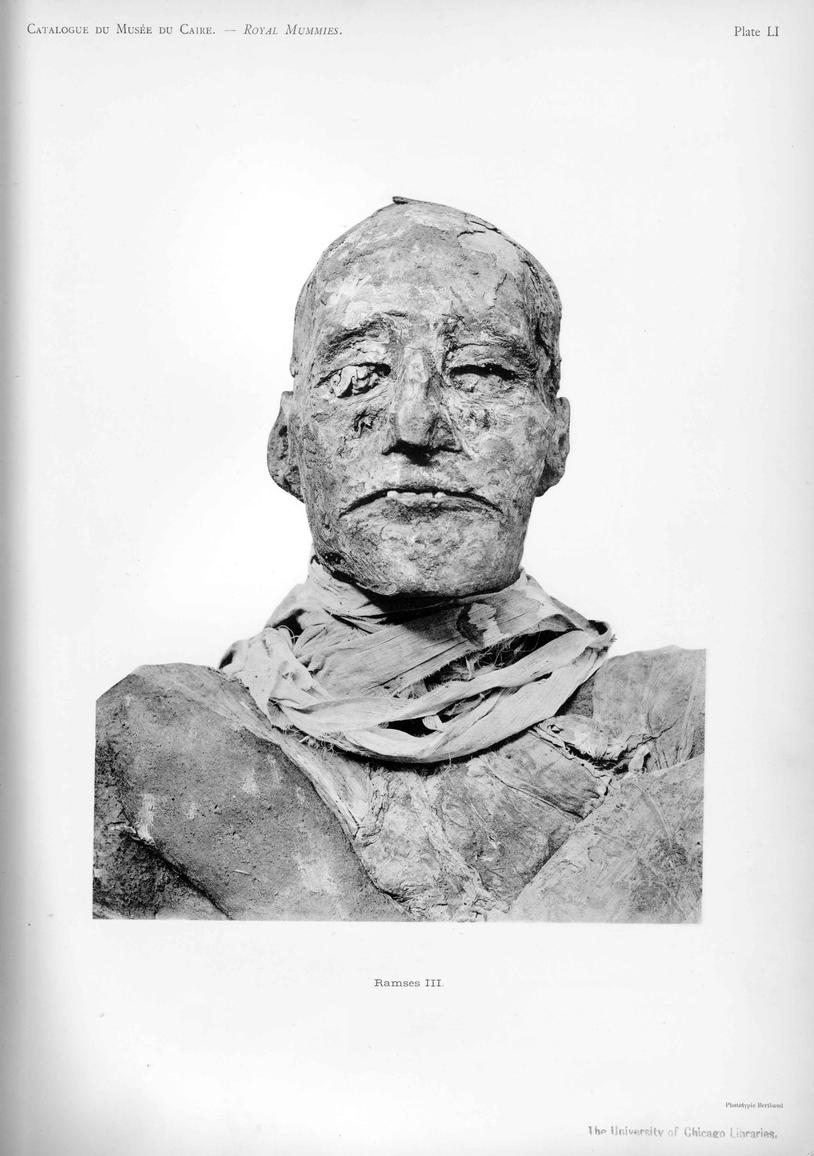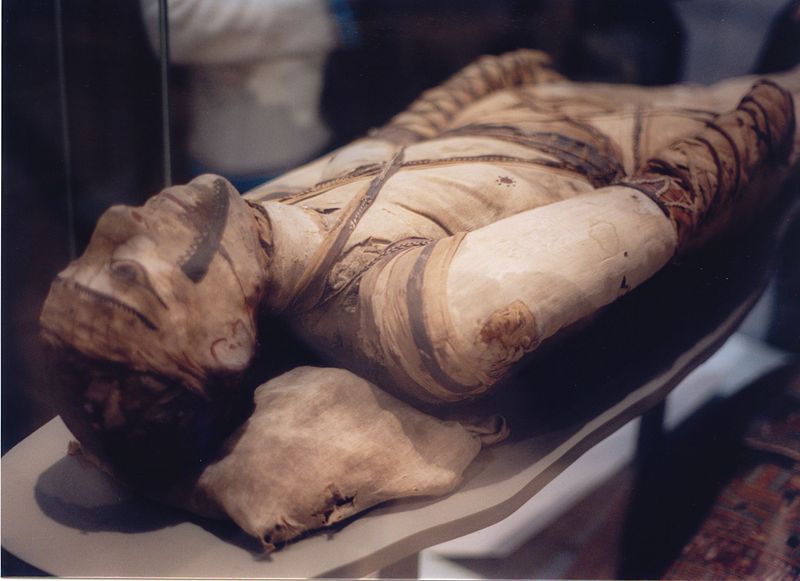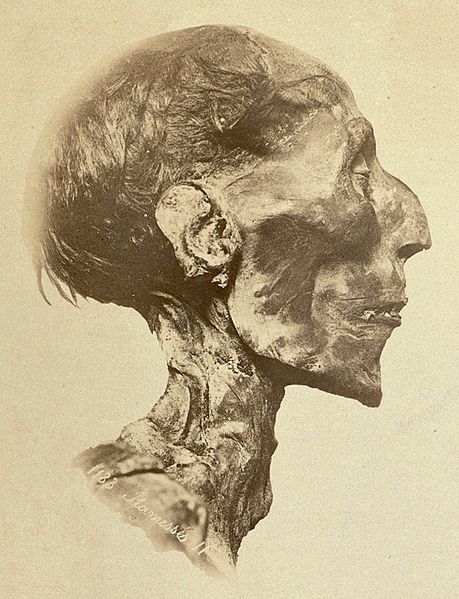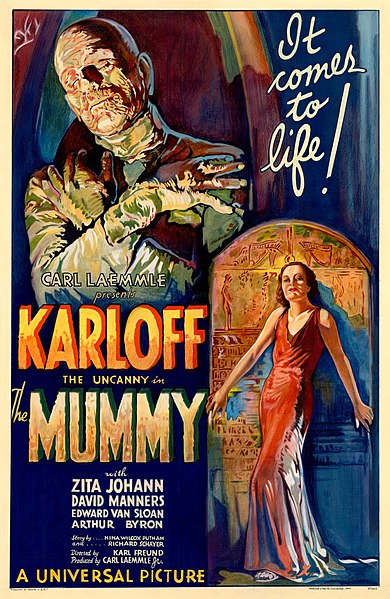.

Head of mummy of Pharaoh Ramesses III: from G. Eliot Smith, Catalogue General Antiquites Egyptiennes du Musee du Caire: The Royal
Mummies Le Caire: Imprimerie de L'institut Francais D'archeologie
Orientale, 1912; image by Anton Gutsunaev, 22 February 2010 (U. of Chicago Libraries)
At court I met it, in clothes brave enough,
To be a courtier; and lookes grave enough,
To seeme a statesman: as I neere it came,
It made me a great face, I ask’d the name.
A lord, it cryed, buried in flesh, and blood.
And such from whom let no man hope least good,
For I will doe none: and as little ill,
For I will dare none. Good Lord, walke dead still.
To be a courtier; and lookes grave enough,
To seeme a statesman: as I neere it came,
It made me a great face, I ask’d the name.
A lord, it cryed, buried in flesh, and blood.
And such from whom let no man hope least good,
For I will doe none: and as little ill,
For I will dare none. Good Lord, walke dead still.
Ben Jonson: On some-thing, that walkes some-where, from Epigrammes, 1616
William Drummond reported of Ben Jonson "that Sir John Roe loved him, and when they two were ushered by my Lord Suffolk from a masque, Roe wrote a moral epistle to him... [saying] God threateneth kings, kings lords, and lords do us. He never esteemeth of a man, for the name of a lord."

Make-up artist Jack Pierce applying the finishing touches to Boris Karloff in preparation for a scene in The Mummy (1932): photographer unknown; image by filmwolf, 18 May 2008

Egyptian mummy in Egyptian Collection, British Museum, London: photo by Klafubra, 14 November 2004

Rameses II -- His mummy, unwrapped: photo by Emil Brugsch (1842-1830), 1889: image by Interbau, 5 November 2011

Pharaoh Seti I -- His mummy, unwrapped: photo by Emil Brugsch (1842-1830), 1889: image by Jeeny, 1 July 2007

Film poster for the 1932 Universal Pictures film The Mummy, directed by Karl Freund: poster attributed to Karoly Grosz; image by Crisco 1492, 3 March 2012 (Los Angeles Public Library)

Film poster for the 1932 Universal Pictures film The Mummy, directed by Karl Freund: poster attributed to Karoly Grosz; image by Feyday, 27 May 2010

Theatrical revival of The Mummy, Paramount Theatre, Syracuse, New York: photographer unknown, 1959; image by William, 7 September 2011



13 comments:
I fell in love
with my Mummy
although
he did not say much
nor give me exact answers
to questions
numerous, unwinding.
Why was he so handsome
when I finally unwrapped him?
Skin so smooth, expression determined
on the little pillow.
Our marriage was one of convenience
me in long dresses waiting by the window
sick about the moonlight
moss dripping from the oaks
out Nonpareil the foggy road
with its deer
their antlers
catching his bandages.
Tom,
Such great photos to go with Jonson's poem -- scary! ("At Tampa I met it. . ." he might have writ last week.)
9.6
light coming into sky above black plane
of ridge, first bird chirping on branch
in foreground, sound of wave in channel
as such, makes it appear as
action following that
form of first term, form of
last term, immaterial
grey white of fog reflected in channel,
cormorant flapping across toward point
Personifying the rich and powerful as The Undead was a device that went back beyond Hollywood and the Tampa Pharaohs, as Ben Jonson (and Stephen) knew, to the Greeks. He employs it here: prosopopoeia, the representing in human form of an absurd or imaginary person or inanimate entity, giving it the capacity to walk, speak, and otherwise simulate actual persons.
In this epigram Jonson's double prosopopoeia personifies as the walking dead whichever member of the ruling classes had snubbed him most recently, and also proposes a credible self-impersonation, a playing of the role of "a Ben Jonson": that is, a brusque, discerning, authoritative observer whose words carry the felt weight of a known public personality. Ben performing "Ben".
The original script for the Mummy, commissioned by Carl Laemmle, Jr. relocates a story about a 3000 year old magician (who survives by injecting nitrates) from San Francisco to Egypt, and makes the hero into Im-ho-tep, an ancient Egyptian priest brought back to life by an archaeologist. Two days before the beginning of filming, the brilliant German expressionist cinematographer Karl Freund (who had shot Murnau's The Last Laugh, Lang's Metropolis, and the original Dracula) was brought on as director, with Charles Sturnar as cameraman. Jack Pierce was hired as make-up artist. Pierce had done make-up for Universal's earlier Frankenstein. To construct a "look" for the Karloff Mummy, he studied photos of the mummy of Pharaoh Seti I (see the German Egyptologist Emil Brugsch's photo of his unwrapped noggin). In the course of production, however, the "look" of the mummy was changed, Karloff shedding the resemblance to Seti I and taking on the appearance of the mummy of Ramesses III. On the set, Karloff's first day featured the emergence of the mummy from his sarcophagus. Pierce started the day at 11 am, applying cotton, collodion and spirit gum to Karloff's face, and clay to his hair, and wrapping him in linen bandages treated with acid and burnt in an oven. This ordeal went on until 7 pm. Karloff finished his scenes at 2 am. Two more hours were spent removing the make-up. The removal of gum from his face was agony for Karloff. He found the day 'the most trying ordeal I [had] ever endured".
Still it remains the case that...
"There's nothing on earth like... the Mummy".
Seti I, Ramses II, Ramses III.
Dead, deader, deadest.
Well it was not always a rose garden down in old Karnak. Pharaoh one day, Rag bag the next, seems to have been the rule.
"Thanks to the discovery of papyrus trial transcripts (dated to Ramesses III), it is now known that there was a plot against his life as a result of a royal harem conspiracy during a celebration at Medinet Habu. The conspiracy was instigated by Tiye, one of his two known wives (the other being Iset Ta-Hemdjert), over whose son would inherit the throne. Iset's son, Ramesses (the future Ramesses IV), was the eldest and the successor chosen by Ramesses III in preference to Tiy's son Pentaweret.
"The trial documents show that many individuals were implicated in the plot. Chief among them were Queen Tey and her son Pentaweret, Ramesses' chief of the chamber, Pebekkamen, seven royal butlers (a respectable state office), two Treasury overseers, two Army standard bearers, two royal scribes and a herald. There is little doubt that all of the main conspirators were executed: some of the condemned were given the option of committing suicide (possibly by poison) rather than being put to death. According to the surviving trials transcripts, 3 separate trials were started in total while 38 people were sentenced to death. The tombs of Tiy and her son Pentaweret were robbed and their names erased to prevent them from enjoying an afterlife. The Egyptians did such a thorough job of this that the only references to them are the trial documents and what remains of their tombs.
"Some of the accused harem women tried to seduce the members of the judiciary who tried them but were caught in the act. Judges who took part in the carousing were severely punished.
"Susan Redford speculates that Pentawere, being a noble, was given the option to commit suicide by taking poison and so be spared the humiliating fate of some of the other conspirators who would have been burned alive with their ashes strewn in the streets. Such punishment served to make a strong example since it emphasized the gravity of their treason for ancient Egyptians who believed that one could only attain an afterlife if one's body was mummified and preserved -- rather than being destroyed by fire. In other words, not only were the criminals killed in the physical world; they did not attain an afterlife. They would have no chance of living on into the next world, and thus suffered a complete personal annihilation. By committing suicide, Pentawere could avoid the harsher punishment of a second death. This could have permitted him to be mummified and move on to the afterlife.
"It is not known if the assassination plot succeeded. However, Ramesses III died in his 32nd year before the summaries of the sentences were composed but the same year that the trial documents record the trial and execution of the conspirators.
"Although it was long believed that Ramesses III's body showed no obvious wounds, a recent examination of the mummy by a German forensic team, televised in the documentary Rameses on the Science Channel in 2011, showed excess bandages around the neck. A subsequent CT Scan revealed that beneath the bandages was a deep knife wound across the throat, a wound deep enough to reach the vertebrae. According to the documentary narrator, 'It was a wound no one could have survived.'
"Prior to this discovery, it had been speculated that Ramesses III may have been killed by means that would not have left a mark on the body. Among the conspirators were practitioners of magic, who might well have used poison. Some have put forth a hypothesis that a snakebite from a viper was the cause of the king's death but this proposal has not been proven. His mummy includes an amulet to protect Ramesses III in the afterlife from snakes. The servant in charge of his food and drink were also among the listed conspirators, but there were also other conspirators who were called the snake and the lord of snakes."
I unwrapped some-poems
and found
they had mummified
before they walked
down the page
of the sacred blog
I mean bog
where it was uncanny
how close to death
they actually were
up in front of the jury.
They exhibited their royal
letters and meager punctuation
upon waking
looking for others
victims
who would usher them
back to the tomb
where they are at home
with their friends
at home amongst
ancient inscriptions
dusky light
golden offerings
all set out
for the afterlife.
Do we shake hands
or just pose
for the photos?
I thought I saw a mummy
leave just now
trailing some bandages
going some-where
it was
some-thing uncanny.
The mummy had a goal
it was to rule
its own coffin
without disturbance.
Material items
cast aside
as mummies tend
to do. Freedom
a sleepy idea
mumbling and groaning
for home but where Mummy?
Or you, playing a mummy
all wrapped up
sorting your
petrified poems
in the tomb
of the forgotten
place you remembered
before being all wrapped up.
At work I met it, in clothes not enough,
To be a reader, and looks scruffy enough,
To seeme a reader: as neere it sang sputtering, swearing,
It made a long face, I knew the name.
A poet, it cryed, polished, true.
And such from which none return untouched,
For I knew some: and as many since,
For I promoted some. Wild Freak, please come alive.
I'm not gonna keep quiet on this one:
from "The Phrase Finder"-
'Mum's the word' has become a popular name for baby product shops and nursery services, but the 'mum' in this phrase isn't mother. Nor has 'mum' anything to do with Egyptian mummies, despite their prolonged taciturn disposition. That 'mummy' derives from 'mum' being the name of the bitumen used for embalming.
The 'mum' of 'mum's the word' is 'mmm' - the humming sound made with a closed mouth, indicating an unwillingness or inability to speak. The word is of long standing in the language and first appeared in print in William Langland's Middle English narrative poem Piers Plowman, circa 1376:
Thou mightest beter meten the myst on Malverne hulles
Then geten a mom of heore mouth til moneye weore schewed!
That loosely translates as 'You may as well try to measure the mist on the Malvern Hills as to try and get her to speak without first offering payment'
Hmmm.....
Is it deflating to suggest a personal experience as derivation of the impulse to post something almost entirely unrelated here in the exalted sanctum of the Great Cyber Sarcophagus?
Preparing the two posts preceding this one became the occasion for many curious memories of their author. One that continues to engage involves RC stalking across the windswept Bolinas mesa late one night and arriving at our door with head self-mummified in strips of aluminum foil. Clearly there is an Archetype at work in all this. In any case, that reminiscence led by the usual association pinball to thoughts of Ben's great self-impersonating bluffer's measurement of the stuffed-shirt lord at St James's. Sometimes the walking dead become more alive in one's aberrant cerebrum than the living dead awake and walking all about one.
Brought back to life
to Live, Love, and Kill
after 3700 years
at least there is a purpose
so ancient
all the rest so bland
like bandages, so cumbersome
my eyes do the work.
Oh Frankenstein oh Invisible Man
and then there's
The Mummy refusing
to be just any old freak.
Buried alive for thousands of years
only to save up for the right time
to exact revenge
on innocent, unsuspecting
modern people
emerging from the earth
is the earth so innocent so unsuspecting
in slow motion
turning into a person
different yet the same.
Mummy, sing me to sleep
wear your big ring
keep up with the times
help me win Publisher's Clearinghouse
or free Reader's Digests
just for fun. Just for kicks.
Post a Comment